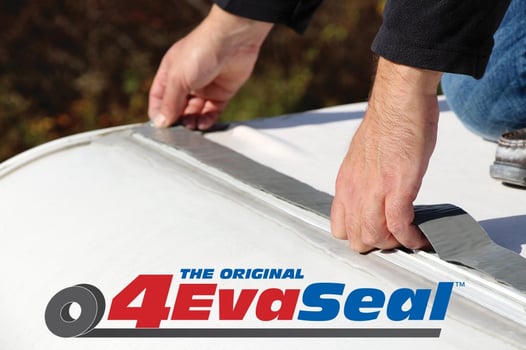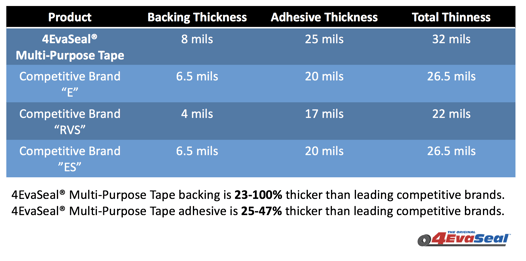
Winter is officially here and for many of us, the cold weather has arrived and looks like it’s here to stay. If your RV’s roof is not yet covered with a blanket of snow, now is the perfect time to seal up any areas where leaks may be present. Keeping moisture out of your RV will prevent unwanted damage, mold and other costly repairs.
There are many sealant tapes to choose from if you are you looking for a simple solution to seal a hole, seam, or tear in your single ply roof. So, the question is, how do you choose the best tape for your needs? Most are competitively priced, but do they match up qualitatively?
All Sealant Tapes Are Not Created Equal
When comparing tapes, some of the most overlooked physical attributes are the thickness of the backing and the thickness of the adhesive. Ultraviolet rays and weather can slowly cause the backing to break down and fail in some tapes. This, in turn, causes the adhesive to degrade quickly. These failures are usually not detected until water leakage has already done damage, resulting in costly repairs.

Thicker Is Better!
Thicker backings take much longer to yield to the effects of the sun, rain, snow, wind, ice, and dirt. A thicker backing provides superior protection for long-term performance. Compare 4EvaSeal Multi-Purpose Tape to other brands. 4EvaSeal tapes are engineered to outlast tapes with thinner backing materials.
The adhesive thickness also plays an important role in the performance of the tape. When pressing, or rolling, the tape into the surface, the adhesive is forced into tiny valleys, holes, and irregularities. Tapes with small amounts of adhesive will struggle to fill these irregularities, allowing pathways for water and air.

4EvaSeal tapes are designed to form a permanent seal against the elements. They bond aggressively and stay bonded. When properly installed, this incredibly well-engineered product has the potential to last as long as the roof system itself
Tips for Cold Weather Installations
Use a hair dryer or heat gun to warm the surface prior to applying the tape. Use the same heat source to warm the tape while simultaneously using a roller to press the tape to the surface.
Apply moderate force to the roller to assure the tape has made full contact with the surface. Proper technique will result in a small amount of adhesive bleeding out (oozing) from the edges.
Want to try 4EvaSeal yourself? Request a free sample.






